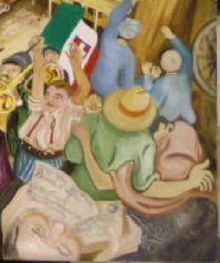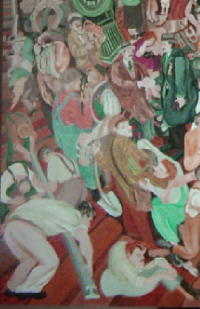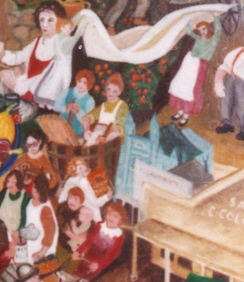Immigrant arrivals and the first settlements.
The End of the Nineteenth Century marked the beginning of large scale Italian Immigration and settlement.

Some Italians of means had already left Italy before the re-unification. Many Northern Italians came to Canada with their families, often starting businesses in Quebec which was predominantly both French-speaking and Roman Catholic. Craftsmen, artists and musicians and learned people followed.
By the end of the Nineteenth Century millions of Italian peasants migrated to South America, the USA, Australia, Western Europe and Canada.
A large number of these new Italian immigrants to Canada settled in townships of Quebec and Ontario, where earlier in the century the British Government had granted lots to Italian mercenaries for their services in the War of 1812. By 1880 there would be over 2,000 people of Italian descent in the Montreal and Toronto areas. Those immigrants that could not get employment in commerce, crafts or teaching took to the streets as itinerant musicians or vendors.
However thousands of Italian immigrants being from rural peasant areas of Italy were without connections or family and had to scramble and compete with other European unskilled workers in a vast rugged country that was just coming of age.
At the end of the Nineteenth Century Canada was a young country.
 In 1841 Canada was just the union of Lower and Upper Canada, essentially Quebec and Ontario, with the addition of New Brunswick and Nova Scotia it became the Dominion of Canada in 1867.
In 1841 Canada was just the union of Lower and Upper Canada, essentially Quebec and Ontario, with the addition of New Brunswick and Nova Scotia it became the Dominion of Canada in 1867.
The confederation of Manitoba, the NorthWest Territories (most of the land having had to be purchased back from The Hudson's Bay Company, including Alberta aand Saskatchewan), was added in 1867, British Columbia in 1871, Prince Edward Island in 1873 , with Newfoundland not being added until 1949 completing the Nation of Canada.
However the economic and political power was firmly planted in Ontario, but heavily influenced by British and American Industrialists who wanted a piece of the future wealth of the new nation.
A History of British Columbia within Canada in the late 19th Century .
Prior to confederation British Columbia had been two provinces, Vancouver Island and Mainland British Columbia with the Capital at New Westminster (Old Westminster being in England!) After protests in 1866, Victoria was made the Capital. In 1871, the then 12,000 residents of British Columbia only agreed to become part of the Dominion of Canada on the condition that
The Federal Government build a Railway from East to West across the Dominion of Canada
linking British Columbia to the East.
The National Dream was born, but it would take another
fifteen years to materialize.

Gold had been discovered on the Fraser River, miners (including many Italians) from the Californian goldfields flocked into British Columbia. Meanwhile in Eastern Canada, the-out-of-work Italians were recruited as navvies (so-called after the Irish and other European labourers that dug the navigation canals during the Industrial Revolution).to labour on the railways, roads and canals being built across the nation. The number of Italian men, young and old far outnumbered
the women, who usually picked up work where they could as domestics, seamstresses, or cooks. If the work ran out, or they were forced to quit, they tried to find other work wherever they happened to be: farming areas, logging camps, coal-mining areas, mining camps, and road building areas from East to West.

By 1900, Italy, with Rome as it's capital, was only 30 years old as a nation, with little direction as to where it was going economically, socially and politically, there were over 10,000 people of Italian origin in Canada, for many it was not the promised land of fortune.
The Industrial advancements North and South of the American border and the availability of immigrant labour spawned networks of professional recruiters that sent workers to anywhere as long as they could make profit from them. The work was low-paid, hard, dirty and dangerous. Shelter was poor and in short supply, disease was everywhere, especially consumption that was pandemic within mining communities. Some unscrupulous agents made employment promises, that they could not keep, with the results that many workers ended up marooned and destitute.
Not all Italian immigrants were intent on settlement in their new country, many of the men had left their families back in Italy, working only temporarily in order to send money back home with the intention of returning to their homeland. These workers were called sojourners, they often worked seasonally returning time and time again. In latin America they were known as golondrinas (swallows).
The Demand for labour and the availability of Immigrants in the homelands gave rise to the 'Padrone' system whereby 'agents - padrone' would find work for the labourers, and help them get shelter and other services for a fee. The sojourners where often recruited in Europe, being without family ties, they were exploited time after time on their return to Canada and USA.
These labour exploitation practises became a major concern for both the Italian and Canadian governments and in 1904 the practices were investigated and halted.
Just prior to World War I, Italian immigration surged, in 1911, a census indicated that there were 46,000 persons of Italian Descent.
During the first world war in 1914, Italy joined with Britain and France to combat Germany, many Italians eager to join their families in the americas, some to escape persecution and others who did not wish to be involved, emigrated.
After the war was over in 1918, many Italians were poorer than ever and without means to make a living.
With mounting economical and political unrest the stage was set for change, and the fascists came to power under the leadership of Benito Mussolini promising the people a better life.
More details of Italy's history during this period at http://www.historylearningsite.co.uk/italy_in_1900.htm
Immigration into Canada came to a halt before and during World War II. in which Italy fought on the Side of Germany.
Both world wars would prove to be an exceptionally difficult period for settled and new immigrants. There were many immigrants who permanently returned to their homeland.
Many Canadians wrongly viewed Italy's siding with Germany as meaning that all
Italian immigrants and persons of Italian descent were siding with Germany and therefore be treated as 'enemies in our midst', inspite of the fact that many immigrant Italians had enlisted and bravely served in combat against their former countrymen.
After the war, the pressure eased, and there followed the most intense mass immigration on record. Between 1948 and 1971, almost 500,000 people from Italy emigrated to Canada raising the total population to 730,000 persons of Italian descent.
In 1967, just one hundred years after confederation, the Governments of Canada changed the Immigration policies with the introduction of a point system applied to all immigrants, this had a great effect on the number of Italians applying for immigration, the numbers decreased by 82%.
Today persons of Italian descent are one of the largest ethnic origin groups, after Canadian, British, Irish, French and German, most of them live in Ontario and Quebec, with approximately 10% residing in British Columbia.
In the USA, persons of Italian descent are the fifth largest ethnic origin group.
References:
Statistics Canada.
J. E. Zucchi, Italians in Toronto: Development of a National Identity, 1875-1935.
The following websites cover Italian immigration in the Americas.
http://www.civilization.ca/cultur/presenza/pszah03e.html
http://www.memory.loc.gov/learn/features/immig/italian4.html
http://deila.dickinson.edu/patagonia/newsite/mosaic01pat/projectsItaliansFiorentino.html

 In 1841 Canada was just the union of Lower and Upper Canada, essentially Quebec and Ontario, with the addition of New Brunswick and Nova Scotia it became the Dominion of Canada in 1867.
In 1841 Canada was just the union of Lower and Upper Canada, essentially Quebec and Ontario, with the addition of New Brunswick and Nova Scotia it became the Dominion of Canada in 1867.
